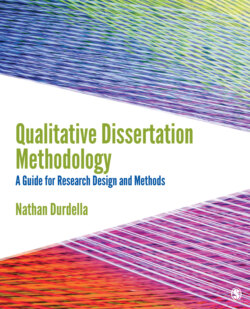Читать книгу Qualitative Dissertation Methodology - Nathan Durdella - Страница 22
На сайте Литреса книга снята с продажи.
Working with standard and emergent approaches in qualitative research.
ОглавлениеMethodology is a complex concept. Schwandt (2007, p. 193) defined methodology as “a theory of how inquiry should proceed” that “involves analysis of the assumptions, principles, and procedures in a particular approach to inquiry (that, in turn, governs the use of particular methods).” Accordingly, Schwandt argues methodology involves a whole set of structures that direct what researchers do in studies that employ specific approaches—from the focus of investigations and the stuff of research problems to the steps in gathering and interpreting information. But methodology’s complexity is more than the sum of its foundational parts. Indeed, researchers have tended to weave epistemological perspectives into an approach and layer methodology with outlooks on how we come to understand the nature of reality. Historically, interpretivism—or the idea of the social construction and reproduction of reality—has been associated with qualitative research methodologies (Merriam, 2009). Recently, though—over the last several decades—qualitative researchers have imbued their approaches with critical, postmodern, and poststructural perspectives. While all of these perspectives share common characteristics with interpretivism, they offer a unique contribution to data collection, analysis, and interpretation—and to the broader goals of a research study. More on these epistemological perspectives and their relationship to qualitative research approaches in Chapter 3!
In practical terms, methodology generally encompasses two major components of a research approach: design and methods. These are the two major sections of the dissertation methodology chapter—usually the third chapter in the traditional monograph format, but Chapter 2 in this book. In turn, these sections tend to be subdivided into smaller sections to outline specific procedural steps. Largely confined to methods, the subsections usually include research setting, data sources and sample, data collection instruments, data collection procedures, and data analysis procedures. In some qualitative dissertation contexts, researcher roles may be included as a separate section, and exact section headings or specific terms associated with subsections may change from one dissertation study to the next.
The overall function of design and methods—methodology—in dissertation studies, as Marshall and Rossman (2010, p. 7) argue, is to articulate how “the study is feasible.” That is, they say, how “the design and methods are the result of a series of decisions . . . made based on knowledge gained from the methodological literature and previous work” (Marshall & Rossman). The methodological framework needs to be connected to more than just specific research approaches and the literature that supports them—researchers must connect what they do in their studies to their empirical and conceptual literature, including the research problem, purpose, and questions that emerged from them. As you shape what your dissertation study looks like, keep this standard in mind: What others have done informs where you go and what you do in the field. You need to demonstrate direct links between your evaluative synthesis of empirical studies and discussion of a conceptual framework with your research questions (and by extension research purpose) and research design and methods. For example, if you have an interest in exploring the experiences of a group of people—as articulated by your research questions—then we would expect to see the use of an ethnographic research tradition in your methodology chapter and observations and interviews in your data collection procedures (and likely a set of analytical techniques associated with ethnography). By contrast, if you intend on examining the relationship among factors associated with a set of experiences or outcomes, then we may see grounded theory as your research tradition (and procedures aligned with grounded theory in the rest of the methodology chapter).
In qualitative research, methodologies tend to be synonymous with research traditions, which Schram (2003) defines similarly: the assumptions, principles, and procedures that guide an inquiry. Still others refer to traditions as research genres. Whatever term you use, the traditions in qualitative research that you tend to see most frequently in the literature include ethnography, phenomenology, grounded theory, and narrative inquiry. There are others, to be sure, which Chapter 3 presents, but these four are used most widely in social science research—from undergraduate and graduate classrooms to methodology texts and empirical studies in the field. What is more, researchers have adapted variations of these primary research traditions as emergent traditions—critical ethnography or feminist research methods as examples—which direct assumptions and principles, along with procedures, toward groups who have been historically marginalized, focus on issues that have not been well understood, and reshape steps to gather and make sense of information in the field. Whether you prefer the term research methodology, research tradition, or research genre—or even research design—you must get to know an approach that meaningfully structures fieldwork and intentionally directs data collection and analysis activities toward your research questions.
